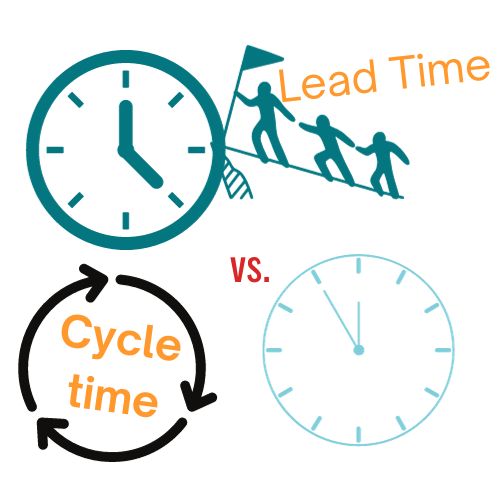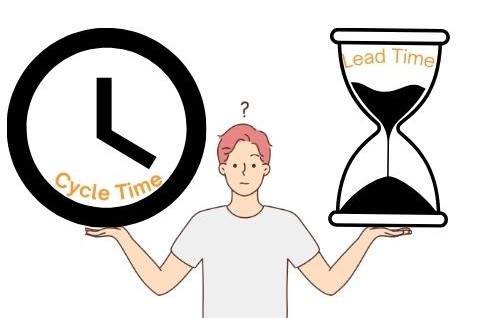Table of Contents
Lead Time vs. Cycle Time Easy Explanation
Introduction for "Lead Time vs. Cycle Time."
The terms “Lead Time” and “Cycle Time” are often used interchangeably when discussing supply chain operations and logistics. However, they refer to different metrics that both provide valuable insights. Understanding the distinction between lead time versus cycle time can help optimize your supply chain, especially when utilizing third-party logistics (3PL) services like those offered by Amazon. Here is the simple answer: Lead time is the time from when the time they make a request to when they receive the product, while Cycle Time is the time it takes a development team to work on the request and deliver it.
In this informational guide blog, we’re going to outline the differences between “Lead Time vs. Cycle Time” and their importance for your business, let’s dive in!
Looking for a 3PL Company for your Amazon Product or Ecommerce Business?
What is Lead Time?
Lead time refers to the total elapsed time from when a customer order is placed to when the order is delivered in full. It encompasses the entire end-to-end workflow from procurement to production to fulfillment and finally delivery.
Lead time is a crucial supply chain metric because it indicates how fast a business can respond to customer demand. The longer the lead time, the higher the risks of losing customers due to slow order fulfillment. Factors that affect lead time include supplier responsiveness, production capacity, inventory levels, and transportation speed.
For 3PL services like Amazon’s, understanding lead time allows proper security protocols to be implemented across the entire supply chain. The more time an order spends in transit or storage, the more vulnerable it is to potential disruptions like theft, damage or delays. Proper security features need to be in place during the lead time to mitigate these risks.
What is Cycle Time?
Cycle time measures the duration required to complete one discrete step or process within the overall supply chain workflow. This could involve production, quality testing, packaging, order picking, or other distinct stages.
Cycle time provides visibility into the efficiency and velocity at which you can complete core operations. Lower cycle times translate to higher throughput and productivity. Cycle time depends on factors like production speed, quality control diligence, and workforce productivity.
For 3PLs like Amazon, managing cycle times properly ensures security measures are upheld during each operational phase. The faster inventory can pass through critical checkpoints, the lower the security vulnerabilities overall.
Comparing Lead Time vs. Cycle Time
While lead time and cycle time metrics both provide valuable insights, there are some key differences between the two:
- Lead time is an end-to-end measure across the entire supply chain, while cycle time focuses on a single process within the workflow.
- Lead time is customer-facing as it indicates order fulfillment speed. Cycle time is internally focused on optimizing specific operations.
- Reducing lead time requires improving coordination across multiple departments and partners. Cycle time relies on optimizations within isolated process steps.
However, efficiently managing both lead and cycle times is crucial for supply chain success. Shortening lead times enables faster order fulfillment and increased customer satisfaction. Optimizing cycle times allows you to boost throughput and reduce operational costs.
For 3PL services, enhanced security is an additional benefit of well-managed times. The faster inventory can move through the supply chain, the lower the risks of disruptions like theft and damage. Amazon’s 3PL solutions offer robust security across operational phases to enable smooth overall workflow.
Tips for Optimization and Security
Here are some tips for optimizing lead and cycle times while boosting security:
- Implement supply chain digitization and tracking tools to identify bottlenecks or lags in lead time. Ensure visibility across all partners.
- Maintain optimal inventory levels to reduce procurement lead time. Use demand forecasting to plan ahead.
- Streamline production through methods like process automation to improve cycle times. Remove redundant steps.
- Perform quality checks at multiple stages to prevent delays but avoid over-inspecting.
- Leverage Amazon’s 3PL security expertise such as 24/7 surveillance, rigorous inspections, and real-time inventory monitoring during all operational phases.
Conclusion
Understanding the nuances between lead time versus cycle time provides valuable insights into supply chain optimization and security. While lead time measures end-to-end workflow duration, cycle time focuses on individual process efficiency. Reducing both metrics can improve customer satisfaction, lower costs and enhance security. However, lead time requires cross-functional coordination while cycle time relies on isolated process improvements. Leveraging Amazon’s 3PL services enables you to optimize these interconnected metrics through inventory digitization, streamlined operations, and stringent security protocols. By gaining a thorough comprehension of lead and cycle times and working with experienced logistics partners like Amazon, you can elevate your supply chain to new heights of efficiency, visibility, and security.
Tactical Logistic Solutions Freight Forwarding Services can be a good addition to your supply chain. We also offer cost-effective Drayage Services
FAQ: Lead Time vs. Cycle Time and Amazon 3PL Security
Lead time is the duration from when a customer order is placed until it is delivered. With Amazon’s 3PL services, lead time is crucial for implementing security protocols. Longer lead times may increase vulnerabilities to theft or damage.
Cycle time refers to the time required to complete a single process in the supply chain. Shorter cycle times often mean that the inventory moves quickly, reducing the time it is susceptible to security risks.
Lead time is an end-to-end measure, while cycle time focuses on individual processes. Lead time is customer-focused, whereas cycle time is process-focused.
Optimize lead time by using real-time tracking, maintaining optimal inventory levels, and ensuring supplier responsiveness. Digitization tools can help identify bottlenecks in the supply chain.
Cycle time can be optimized by streamlining production processes, implementing quality control checkpoints, and using process automation where possible.
Amazon’s 3PL services offer robust security features like 24/7 surveillance, advanced tracking, and stringent quality checks. These features are designed to protect your inventory throughout both lead and cycle times.












